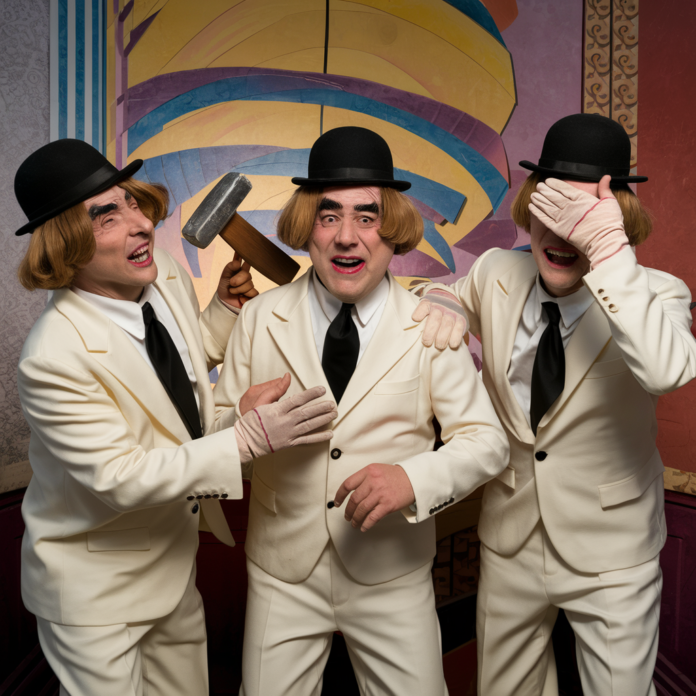In an era dominated by productivity hacks, optimized lifestyles, and relentless self-improvement, TheStoogeLife emerges as a rebellious celebration of glorious nonsense. Inspired by the chaotic charm of classic slapstick comedy, this philosophy rejects the pressure to always be “on” and instead champions the art of playful imperfection. Whether it’s finding humor in daily mishaps or deliberately inviting whimsy into routine moments, The Stooge Life is about trading curated perfection for authentic, unfiltered joy. This article explores how embracing our inner stooge can lead to greater creativity, resilience, and connection in a world that often takes itself too seriously.
The Three Stooges Effect: Why Chaos Breeds Creativity
History’s greatest innovators—from Einstein to Jobs—understood that breakthroughs often emerge from playful experimentation rather than rigid discipline. The Stooge Life takes this further by intentionally incorporating controlled chaos into daily existence. When we allow ourselves to stumble, improvise, and laugh at our mistakes (like the iconic pie-in-the-face gag), we activate divergent thinking.
Neuroscience confirms that humor and absurdity stimulate the brain’s default mode network, sparking unexpected connections. Companies like Google and Pixar already harness this principle with “failure celebrations” and improv workshops. By adopting a stooge mindset—where spilled coffee becomes a slapstick moment rather than a frustration—we rewire our relationship with setbacks, transforming them into creative fuel rather than shame triggers.
Anti-Hustle Culture: The Stooge Manifesto for Work/Life Balance
While influencers preach 5 AM routines and side hustles, The Stooge Life proposes an alternative: strategic ridiculousness. This isn’t about laziness, but about rejecting the lie that worth is tied to perpetual productivity. Imagine workdays with “clown breaks” (inspired by hospital clowns’ proven stress-reduction effects), or emails punctuated with absurd GIFs to disrupt corporate stiffness.
The stooge approach mirrors ancient wisdom traditions—Taoism’s “wu wei” (effortless action) or Zen’s “beginner’s mind”—but with rubber chickens and whoopee cushions. Studies show that teams embracing humor see 23% higher productivity and 40% reduced burnout. In a world where “quiet quitting” became a rallying cry, The Stooge Life offers something more radical: loud, joyful engagement on our own terms.
Stooge-Proof Relationships: How Absurdity Deepens Connection
Modern relationships often suffer from performative seriousness—stiff first dates, conflict-avoidant politeness, and Instagram-perfect anniversaries. The Stooge Life disrupts this with intentional silliness as bonding ritual. Couples who engage in novel, playful activities (like impromptu fake mustache selfies or exaggerated pretend arguments) report higher relationship satisfaction, according to University of California studies.
Friendships, too, thrive when built on inside jokes rather than transactional networking. The viral trend of friends recreating Three Stooges eye-poke gags (safely!) exemplifies this. Even parenting benefits—children with “silly” parents show greater emotional resilience. By giving permission to be goofy, we create psychological safety where authentic connection flourishes beneath the surface of shared laughter.
Designing a Stooge-Friendly World: Architecture, Fashion & Beyond
The built environment increasingly reflects stooge philosophy. Architects integrate “fun theory” into spaces—Singapore’s slides in office buildings, or Helsinki’s “playable sidewalks” with embedded piano keys. Fashion sees a resurgence of oversized bowties, polka dots, and mismatched patterns as wearable joy. Even urban planning gets in on the act with “disobedient objects”—like London’s swinging benches or Barcelona’s giant sidewalk bubbles.
These aren’t frivolous; they’re antidotes to the alienation of sleek, impersonal design. Research confirms that playful public spaces reduce antisocial behavior and increase community bonding. The Stooge Life reminds us that environments shape behavior—when we design for whimsy, we invite people to shed their guarded selves.
The Dark Side of Stoogery: Navigating the Line Between Liberation and Irresponsibility
Like any philosophy, The Stooge Life requires nuance. There’s a crucial difference between therapeutic absurdity and weaponized incompetence (“I burned dinner—so wacky!”). The movement’s critics argue it risks trivializing real struggles or enabling avoidance. True stoogery isn’t about evading accountability, but about reframing life’s inevitable stumbles with levity. It works best when paired with emotional intelligence—knowing when a coworker needs a well-timed whoopee cushion versus a listening ear.
The Japanese concept of “bakku-shan” (finding beauty in imperfection) offers balance here. Ultimately, The Stooge Life succeeds when it becomes a lens, not an escape—a way to engage more deeply with reality by first laughing at its inherent ridiculousness.
Future of the Movement: Can Stooge Philosophy Scale?
As AI automates routine tasks and VR blurs reality’s edges, The Stooge Life may become vital cultural infrastructure. Early signs abound: Zoom meetings where CEOs appear as potatoes, or protest movements using satire as their sharpest weapon. Forward-thinking educators are testing “clown classrooms” where wrong answers earn celebratory confetti. The challenge lies in institutionalizing play without bureaucratizing it—keeping the spirit spontaneous. Perhaps the next frontier is “augmented absurdity,” where AR glasses overlay the world with cartoonish filters, making every sidewalk crack a potential punchline. Whatever form it takes, The Stooge Life endures because it answers a primal need: to balance life’s unavoidable struggles with equally unavoidable silliness.



